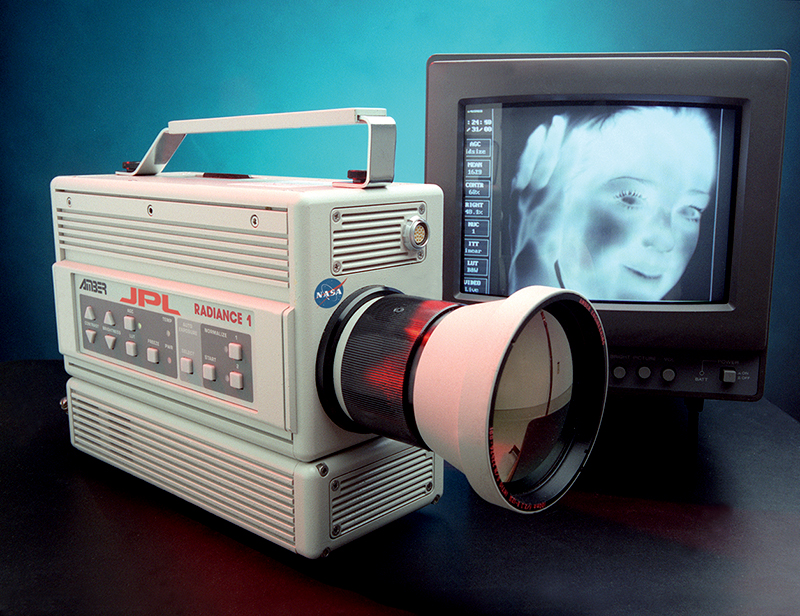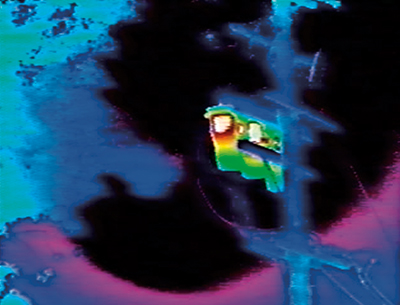
Fully “Eqwipped” to See the Heat
Commercial and government applications that require high performance, long wavelength infrared imaging are no longer being left in the dark, due to a unique technology that is capable of performing tasks that were previously too expensive to accomplish for most users.
Developed by NASA's Jet Propulsion Laboratory (JPL) over the past decade with an excess of $15 million of government research and development investment, quantum well infrared photodetectors (QWIPs) are infrared imaging sensors that can operate in the long wavelength portion of the electromagnetic spectrum, where objects at an ambient temperature emit the most energy. The QWIP technology is used to map planetary atmospheres, observe rocket launch plumes, and detect hot spots beneath the ground after a wildfire has been extinguished. The infrared technology also directly benefits various aspects of everyday life, including roadway safety, security and surveillance, medical imaging, anti-terrorism, fire fighting, search and rescue, law enforcement, and predictive industrial maintenance. JPL's sensors were even used to image and measure features of Hawaii's Mount Kilauea volcano, where they portrayed a hot lava tube running underground, invisible to the naked eye.
QWIP Technologies (QWIPTECH) of Altadena, California, was formed in July 1998 to offer JPL's QWIPs in a commercial format. The company currently holds an exclusive worldwide license to manufacture and sell the infrared photodetector sensors as part of a focal plane array (FPA) called a QWIP Chip.™ The QWIP Chip provides high thermal sensitivity (0.001°C) and possesses a broad dynamic range, permitting precise observations over a wide range of temperatures. For instance, since the technology uses heat rather than light, it can "see" in complete darkness and through conditions such as dust, smoke, and light fog. QWIP Chips also contain lower noise characteristics than other multiple quantum well designs, according to QWIPTECH.
Because image resolution is contingent upon the number of receptors (or pixels) applied to a FPA, QWIPTECH designed a series of QWIP Chip devices, the smallest one having a total of 81,900 pixels per unit, and larger units with more than 300,000 pixels. Although such a vast quantity of receptors usually increases the cost, QWIPTECH was able to develop a high-quality product without sacrificing price or performance, further expanding the capabilities of infrared technology and satisfying strong market demands for a multitude of new users.
The company currently offers a wide range of affordable commercial products, which includes a 320 x 256 FPA and a large format 640 x 512 FPA. Complementary sensor engines, camera modules, and full camera systems are also available.
QWIPTECH, along with its JPL team partners, are working under a current $1.6 million contract with the U.S. Defense Advanced Research Projects Agency (DARPA) to develop the next generation QWIP multicolor FPA. This 2-year effort will lead to the production of FPAs for simultaneous visible and infrared measurements in the first year, and four-color integrated FPAs in the second year.
While the technology has already made a good impression on multiple industries, QWIPTECH and its sister company, InTransTech Corporation, recently teamed up with the Insurance Corporation of British Columbia—one of the largest auto insurance firms in North America—in an effort to potentially save lives and increase road safety, using QWIP technology. In 2001, British Columbia motorists reported more than 10,000 accidents involving wildlife, resulting in costly insurance claims.
As a possible solution, a QWIPTECH prototype camera will be installed on the side of a highway where it will take continuous live video pictures of a stretch of road several kilometers long. The camera will be able to detect the presence of an animal such as a deer, moose, or bear, long before a motorist approaches. The QWIPTECH camera will then relay the animal's image to a computer that will convey information about the animal to a brightly lit digital sign that will act as a warning mechanism for oncoming drivers. Full-scale production and installation of more systems is expected to occur in 2003.
QWIPTECH's patented QWIP technology was inducted into the U.S. Space Foundation's Technology Hall of Fame on April 12, 2001, and was hailed as technology for the future by U.S. Senator John Glenn in an address to the President of the United States and the Senate around the time of the induction.
QWIP Chip™ is a trademark of QWIP Technologies.

QWIP Technologies used the infrared imaging sensors to obtain a nighttime image for preventative maintenance of a transformer on a telephone pole.

The JPL camera features a large-area, long wavelength QWIP focal plane array, which gives it greater sensitivity, resolution, and stability than previous infrared cameras.













